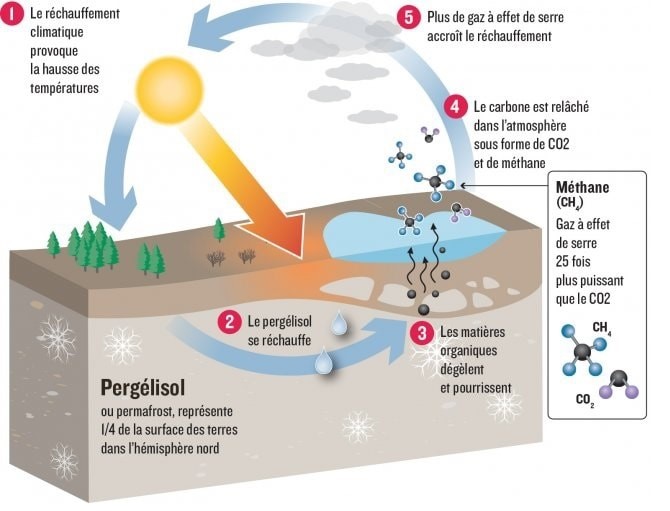Thawing permafrost
Thawing permafrost can have many environmental and socio-economic impacts, particularly on remote communities and Indigenous populations in northern Quebec.
Socio-economic impacts
Infrastructure
Quebec’s northern regions are already facing major infrastructure-related challenges due to the thawing of the permafrost. When buildings, roads or airstrips are constructed on soil that is sensitive to thawing, significant damage can result due to the instability and settling of the ground. It also increases the risk of land movements, including landslides.
Transportation infrastructure can also warp, crack or collapse, increasing the accessibility problems in these remote areas. Building foundations can weaken or become unstable due to a loss of soil solidity, endangering occupants. This also leads to higher construction, maintenance, repair and insurance costs for communities.
In 1998, 20 houses had to be relocated following a landslide in the village of Salluit in northern Nunavik. This operation, carried out in a state of urgency, cost the government millions of dollars, not to mention the social and psychological consequences of these relocations on the inhabitants.
Evaluation of the impacts of climate change and its costs for Quebec and the Quebec government
This project identified and quantified the impacts of climate change, including permafrost thawing, on health and infrastructure in Quebec. The research made it possible to estimate the costs both to the government and to society as a whole, based on existing information in the literature. The results show that the costs to the government of the thawing permafrost amounted to $64 million in 2015, but could reach $217 million by 2065, taking into account the expected strong population growth.
Environmental impact
Release of greenhouse gases
The thawing permafrost could exacerbate global warming by increasing greenhouse gas emissions. Although data specific to Quebec is not available, international studies show that the permafrost contains about 1,700 billion tonnes of carbon dioxide (CO2) and methane (CH4), more than double the amount currently present in the atmosphere. If these huge amounts of greenhouse gases are released from the permafrost into the atmosphere, that can reinforce the effects of climate change.
Water contamination
The permafrost is also known to contain many contaminants that can harm the northern environment. The glaciers and permafrost in northern Quebec have stored huge amounts of mercury for thousands of years. However, with global warming, it is estimated that thawing permafrost in the northern hemisphere could release about 800 million kilograms of mercury by 2100. Mercury is a heavy metal that may be released into the groundwater, lakes and rivers, affecting water quality in the region. The health of northern communities could also potentially be affected by the ingestion or absorption of contaminated water.

Figure 7 : Cycle of atmospheric warming due to permafrost thaw. Source
The changing northern landscape
Rising sea levels combined with the thawing permafrost may also cause increased coastal erosion and flooding that can threaten northern coastal regions. These factors will alter northern landscapes and affect local communities near the coast, causing the loss of part of their land and damage to infrastructure.
In permafrost regions, soil near the shores is particularly vulnerable due to its fragility and instability, which can cause landslides.
Impact of climate change on Nunavik’s marine and coastal environment: Overview
The aim of this project was to create a decision support tool that aggregates key knowledge on the impacts of climate change on the marine and coastal environment in Nunavik. Its report covers the results of several studies coordinated and/or funded by the Ministère des Transports du Québec in order to ensure effective access to and transfer of the knowledge developed through various research projects and to promote its use to support the implementation and monitoring of adaptation.